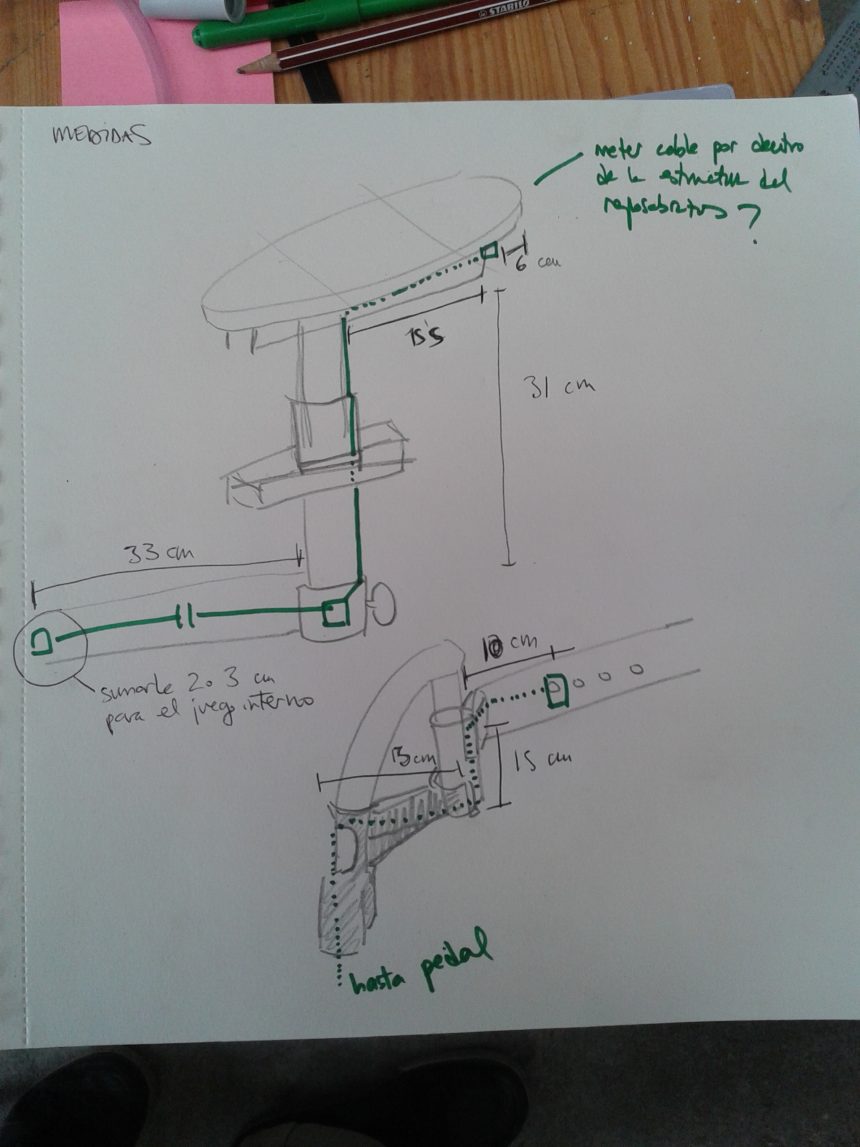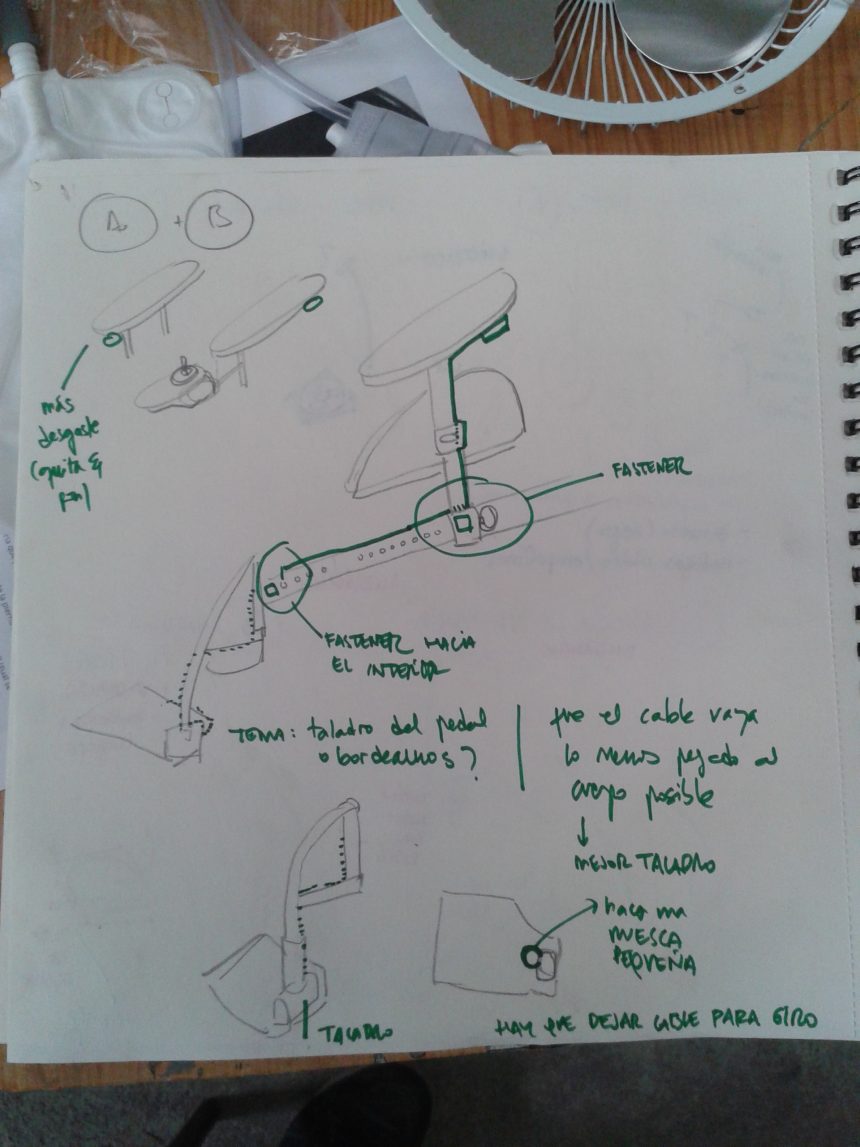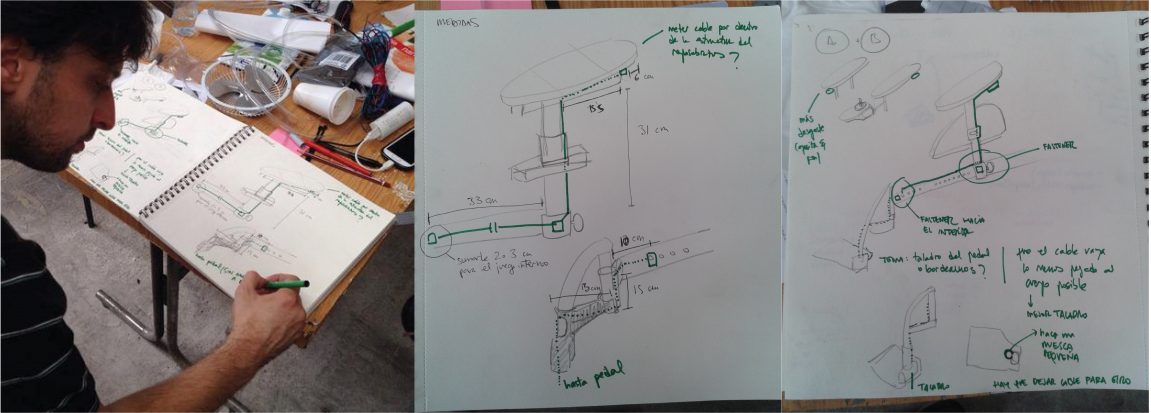A re-description of my two-fold engagement as ethnographer-cum-documenter in the activist design collective En torno a la silla. Highlighting the importance of note-taking as a ‘fieldwork device’ for the problematizing and relating in the field.
In the updated version of Partial Connections, Marilyn Strathern searches to reveal the fractal imagination at work in the composition of the book. [1] In a way she ‘clarifies’ how she tried to purport that the problem of contemporary anthropology is one related to the kind of complexities derived from ‘adding up’ material, and the everyday problem of ‘writing anthropology’: or producing accounts and ordering them, addressing the complex comparative effects created by ‘cutting’ and ‘adding up’.
Her way of addressing recursivity and ‘ethnographic effects’ is extremely inspiring to me, because since 2012 I have been collaborating as ethnographer/documenter in En torno a la silla, a design collective for the auto-fabrication of gadgets with and for bodily diversity. In there what I could call my ethnographic material has been many times displaced to or produced through different digital forms of record which were not only useful to me but for the joint aims of the on-going project (minutes of meetings; using online archives to store pictures, emails, scanned sketches, etc.; the collaborative production of different videos, tutorials, how-to guides, political reflections and their traceable drafts).
In my work I have been many times worried by not having ‘enough’ material I could call my own in a context where there was ‘plenty’ of collaboratively made material available. To reflect about the strange effects these digitally available notes entailed, I might need to bring forth a puzzling figure of complexity. Hence, I will address my own ethnographic activity as a ‘duplicitous’ one. I use this term to hold in tension two meanings: [2] On the one hand, the etymological sense of a paradoxical quality of being ‘two-fold’ (digitally available notes but not-only, field-notes but not-only). On the other hand, the sense of being a ‘deceitful ethnographer’: both with regards to the ethnographic canon–since I was always doubtful whether what I was doing in documenting and the collaborative work it entailed and opened up might be called ethnographic work–, and to my own ‘epistemic partners’ in relating to them ethnographically–hence ‘adding up’ a personal interest in the collective situations and activities they did not share at all.
However, the possibility to reflect on this ‘duplicitous-ness’ was not always there. And here I’d like to show a particular ‘ethnographic moment’ that afforded this reflection. [3] The Cacharratón (Tinkerthon) was a joyful and mostly for fun co-creation workshop that took place on October 11, 2014 co-organized by En torno a la silla and a studio called Co-Creable.
As I will show, this re-presentation of my own activity as documenter, and the ‘ethnographic effect’ of the product of that task, allowed me to speculate on the two-fold nature of my engagement in my otherwise complex ethnographer-cum-documenter mode: there I was both taking fieldnotes (in my role as ethnographer) and producing field’s notes (in my role as design documenter). I hope this figure of ‘duplicitous’ complexity might allow a reflection on the analogies and diffractions of both activities of note-taking, and their effects.
So, allow me to tell you a story with the following images…

This image (taken by one of the members of En torno a la silla and sent to me through WhatsApp, with a bit of ironic retaliation of the fact that I was doing this constantly to others and I hate being depicted, touché!) pictures yours truly documenting the on-going results of a tinkering exploration we were undertaking in one of the groups of the Tinkerthon. We were attempting to prototype an automated hydroelectric system so that our powered wheelchair-using friends could void the urine bags most of them carry attached to their legs on demand, since these bags limit the ‘range’ of their strolls in the city (even more than the wheelchair’s battery).
My role in the group was to be its documenter, and I sought to jot down different diagrams and schematic sequences of the different attempts as well as the issues related to where to place the button interface to activate a water pump the colleagues from MakerConvent had downloaded from an online repository. Whilst they worked throughout the day 3D-printing, testing, and adapting of the water pump, the rest of the group sought to create a mock-up of the potential emplacement of the tubes and circuits together with Nuria–a renown independent-living activist–, using her experience and her wheelchair as a referent, and a spare and semi-broken wheelchair as a real-life model for our prototyping endeavours.


These two pictures are my own. They show what to me was the outcome of the process depicted in Image 1. We were not only measuring and identifying the wheelchair’s pieces, but also reasoning as we explored and sketched out its possibilities to emplace the hydroelectric system for the emptying out of the urine bag. Images 2 and 3 show different potential emplacements of where the button could be placed under the armrest, and where circuits might travel to reach the wheelchair’s footrest depending on the different emplacements.
These images were not representations of a finished object, but by-products of a reasoning process. Indeed, particular forms of note-taking (as in drawing, sketching and modelling practices) are also vernacular practices of the process of figuring out the material limits and possibilities, as well as what is at stake in design. That was the role I had set for myself that day: I had ‘decided’ that I was just going to document for fun, with no ethnographic tension; I mean, just for the sake of being there, sharing the moment with others, enjoying the process of prototyping and thinking alternatives for the mock-up we had to show once the day ended.
But in time, and when I sought to describe and write down what that day was ‘ethnographically’, I had to draw on the pictures and materials collectively gathered by En torno a la silla, which I had also helped compile and store in a common online platform. Suddenly, I realised that I could only re-tell the intricate technicalities of some of the prototyping processes using the remnants from my non-ethnographic engagement–pictures like these ones, showing the sketches–, since the sparse text notes I took from that day were not of much help. For some time I had taken these pictures to be nothing more than mere token records from that day. Hence, I was astonished: the sketches I had produced, together with the pictures, were the best possible field-notes one could have taken from the process, even not wanting to! But the juxtaposition of Images 2 & 3 with Image 1 only created a further puzzlement.
Allow me to elaborate here on the complexities that these two ‘dazzles’ (to keep following the Strathernian wording) helped me word out: Having in view these three images together in a way was something of a ‘glitch’ forcing me to think of what was not always separated (the deep activist and ethnographic engagements through different works of documentation). But this also entailed a ‘glitch’ showing me the complex modes of note-taking. And a series of questions started to linger: What were these?
Could these ‘notes from the field’ that I had produced as a non-ethnographer-documenter that day be taken as field-notes on which the ethnographer-documenter I am in writing this could dwell ethnographically? Could I consider then these notes from the field as field-notes, irrespectively of their different intention? Besides, what was note-taking doing to this particular field, then? Wasn’t I producing the very field and object of my inquiry in my duplicitous engagement as ethnographer and as documenter? Was there anything I was doing wrong? Was there any other possibility?[4]
Indeed, the juxtaposition of these pictures created a strange ‘baroque effect:’ in a way they were taking the insides of the practice of note-taking out.[5] I could feel their two-fold nature– being actively taken or later on re-taken from the collaborative online archives–. Then again that made me reflect on potential issues of duplicitousness: Had I been literally taking part in the construction of my very own ethnographic research object through documentation? Well, I hesitate to go that far, but I suspect that this might be the unavoidable fate of particular settings in which how we relate (tell) is a quintessential aspect of its very forms of ‘relating’ (sociality), such as when addressing the role of documenters in collaborative and open design practices.
In fact, it was precisely because of their status of ‘digitally available’ records that they allowed me to undertake a re-description:[6] that is, a mode of ‘relating’ directing my gaze to what I was doing in there–paradoxically acting as ‘relator’–and its effects. But also affording the very possibility of finding ways for its re-telling, since I could only engage in such a reflection grounding on what they made available.
This was one of the many triggers of a still on-going conversation with Adolfo Estalella on a re-description of ethnography through our ‘fieldwork devices’. That is, devices affording modes of problematization in the field and ‘devicing’ how we relate in the field. For instance, my engagement with open documentation many times entailed the resource to devices that were both crucial for my ethnographic undertaking and the object of my research, objects whereby I undertook research but which were also recursive on the modes we related. Prototypical ‘research objects’, analogous to the tinkering explorations I was following, that helped us recursively prototype our relations through moments of shared reasoning of who we were there and what we were doing together.
In fact, the personal dazzle with my two-fold engagement I described beforehand is just a way of addressing the many forms of ‘joint dazzle’ that these records I was helping produce and then putting to the avail of others helped us have, constantly redefining the prospects and the aims of our modes of situating ourselves En torno a la silla (around the wheelchair), a mode of relating in itself!
In sharing many of these puzzlements together with Adolfo’s, we have tried to find how to generate a vocabulary and a mode of description addressing the particularly interventionist features of this mode of undertaking fieldwork as well as its relational effects, usually generating experimental forms of anthropological ‘joint problem-making’. However, I think this is just one particular mode of the many kinds of recursions happening in heavily-mediated ethnographic projects using films or exhibitions as a mode of undertaking research. Indeed, this ‘provocative’ effect (where our records or research activities provoke reality) has been beautifully rendered by Paul Henley in his account of Jean Rouch’s films and writings foregrounding what he called ‘shared anthropology.’ Henley’s book shows beautifully how the filmic records (always produced in particular ways, genres or styles), also had an impact in the very articulation of fieldwork per se, where in practices such as public screenings “the camera [acts] as a catalyst that can provoke a performance on the part of the subjects” (Henley, 2009: 349).[7]
These are particular fieldwork situations where ethnographic records, in whatever media they might be produced–and it would be nice to think of how the different media, formats and genres of our records produce particular versions of the world–become part of its realization:
That is, the becoming-real of a particular field, where rather than starting from a theoretical construction of our ‘research object’ to engage in a solitary activity of field-working, we might end up engaging in a literal construction of objects through which we do research. I will close with a small reflection on what this story I told might do to the activity of taking field-notes. In showing my field-notes to reflect on them, I sense there’s something more than a mere gesture of ethical purification or epokhē (showing the ‘naked truth’ of ‘data’ in all its alleged ‘rawness’ to depict the anthropologist’s theoretical and political imaginations at work, and its potential effects on the people and things being accounted for) or even of ‘contextualising’ and ‘being reflexive’ for that matter.
Searching to ‘provide context’ might not do justice to the recursive effects of our ethnographic practice with fieldwork devices. What the juxtaposition of those images and the ‘dazzle’ they created to help me think of one of them (note-taking) allowed me was a ‘re-descriptive’ moment: authorising me to pay attention to how these different forms of inscription open up worlds for particular forms of inquiry and conceptualization. And, reversely, how worlds of inquiry take shape through the very act of recording (a fieldwork device duplex?). This is where I believe searching to produce more or less artificially moments of ‘re-description’ could be inspiring not only forcing us to focus, beyond taken-for-granted-ness, on the different types of note-taking, but also paying attention to their relational effects in our very fields.
Could we craft ethnographic stories focusing on our fieldwork devices and how they impinge on our ways ‘to rethink how we think’, or ‘re-learn how we learnt’ ethnography, or the ‘tricks’ or ‘hacks’ we needed to produce when recording, documenting, inscribing a particular situation or event and its effects? That is, to understand and re-craft what the anthropological endeavour is or should be about, and the kinds of intellectual and descriptive operations at work in the mundane activity of taking notes?
[1] Strathern, M. (2004). Partial Connections (Updated Edition). New York: Altamira Press.
[2] Both “the quality or state of being double or twofold”, and “deceptive in words or action”.
[3] “a relation which joins the understood (what is analysed at the moment of observation) to the need to understand (what is observed at the moment of analysis)” Strathern, M. (1999: 6). Property, Substance and Effect: Anthropological Essays on Persons and Things. London: Athlone Press.
[4] Paradoxically, reflections on the practicalities of note-taking for ethnography–its styles, genres, gadgets or infrastructures–are scarce. To my knowledge, the best examples might be: Sanjek, R. (Ed.). (1990). Fieldnotes: The Makings of Anthropology. Ithaca, NY: Cornell University Press; Emerson, R. M., Fretz, R. I., & Shaw, L. L. (1995). Writing Ethnographic Fieldnotes. Chicago: Chicago University Press.
[5] Corsín, A. (2015). The capacity for re-description. In T. Yarrow, M. Candea, C. Trundle, & J. Cook (Eds.), Detachment: Essays on the limits of relational thinking (pp. 179–196). Manchester: Manchester University Press.
[6] Lebner, A. (2017). Strathern’s Redescription of Anthropology. In A. Lebner (Ed.), Redescribing Relations: Strathernian Conversations on Ethnography, Knowledge and Politics (pp. 1–37). Oxford: Berghahn.
[7] Henley, P. (2009). The Adventure of the Real: Jean Rouch and the Craft of Ethnographic Cinema. Chicago: University of Chicago Press.
Text adapted from the one published in Allegra Lab (September 22, 2017)

